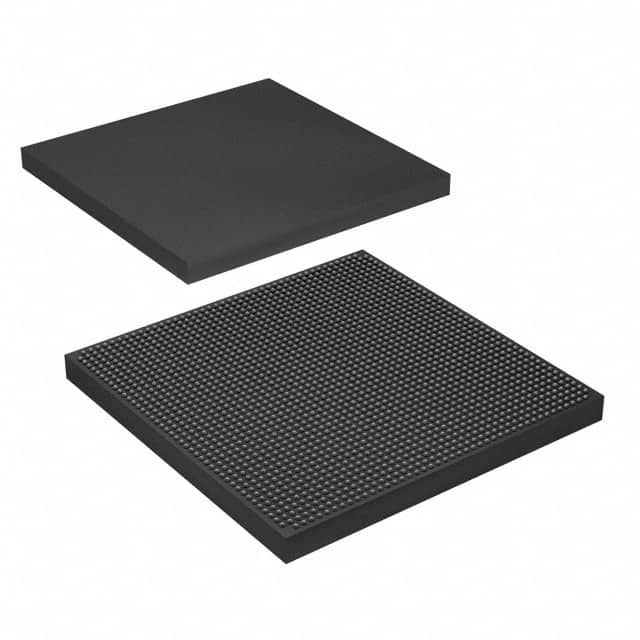Xem thông số kỹ thuật để biết chi tiết sản phẩm.

5SGXEA9N2F45C3N
Product Overview
Category
The 5SGXEA9N2F45C3N belongs to the category of Field-Programmable Gate Arrays (FPGAs).
Use
FPGAs are integrated circuits that can be programmed and reprogrammed to perform various digital functions. The 5SGXEA9N2F45C3N is specifically designed for high-performance applications.
Characteristics
- High-performance FPGA
- Programmable and reprogrammable
- Versatile and flexible
- Offers high-speed processing capabilities
- Supports complex digital designs
Package
The 5SGXEA9N2F45C3N comes in a compact package suitable for integration onto printed circuit boards (PCBs).
Essence
The essence of the 5SGXEA9N2F45C3N lies in its ability to provide customizable digital logic functions, allowing designers to implement complex systems on a single chip.
Packaging/Quantity
The 5SGXEA9N2F45C3N is typically packaged individually and is available in various quantities depending on the requirements of the project.
Specifications
- FPGA Family: Stratix V
- Logic Elements: 462,000
- Embedded Memory: 22,680 Kbits
- DSP Blocks: 1,288
- Maximum User I/O Pins: 1,040
- Operating Voltage: 1.0V
- Operating Temperature Range: -40°C to 100°C
- Package Type: FCBGA
- Package Size: 45mm x 45mm
Detailed Pin Configuration
The detailed pin configuration of the 5SGXEA9N2F45C3N can be found in the manufacturer's datasheet or reference manual. It provides information on the specific functions and connections of each pin on the FPGA.
Functional Features
- High-speed processing capabilities
- Configurable logic elements for custom digital designs
- Embedded memory blocks for data storage
- Digital Signal Processing (DSP) blocks for signal processing tasks
- Flexible I/O interfaces for communication with external devices
- Support for various communication protocols
- On-chip clock management resources for precise timing control
Advantages and Disadvantages
Advantages
- Flexibility: FPGAs can be reprogrammed to adapt to changing requirements.
- High Performance: The 5SGXEA9N2F45C3N offers high-speed processing capabilities.
- Integration: It allows complex systems to be implemented on a single chip.
- Customizability: Designers have full control over the functionality of the FPGA.
Disadvantages
- Complexity: Programming and designing with FPGAs can be challenging for beginners.
- Power Consumption: FPGAs tend to consume more power compared to other integrated circuits.
- Cost: FPGAs can be relatively expensive compared to other alternatives.
Working Principles
The 5SGXEA9N2F45C3N operates based on the principles of reconfigurable hardware. It consists of an array of configurable logic elements, memory blocks, and DSP blocks interconnected through programmable routing resources. The FPGA can be programmed using Hardware Description Languages (HDLs) such as VHDL or Verilog, which define the desired digital logic functionality. Once programmed, the FPGA executes the specified logic operations, allowing it to perform various tasks.
Detailed Application Field Plans
The 5SGXEA9N2F45C3N finds applications in a wide range of fields, including:
- Telecommunications: Used in base stations, network routers, and switches for high-speed data processing.
- Aerospace and Defense: Employed in radar systems, avionics, and military communication systems for their high-performance capabilities.
- Industrial Automation: Utilized in control systems, robotics, and machine vision applications for real-time processing and control.
- Medical Devices: Integrated into medical imaging equipment, patient monitoring systems, and diagnostic devices for data processing and analysis.
- Automotive: Used in advanced driver-assistance systems (ADAS), infotainment systems, and engine control units (ECUs) for enhanced functionality.
Detailed and Complete Alternative Models
- Xilinx Virtex UltraScale+ VU9P: Offers similar high-performance capabilities with a larger logic capacity.
- Intel Stratix 10 GX: Provides advanced features and higher logic density compared to the 5SGXEA9N2F45C3N.
- Lattice ECP5: A cost-effective FPGA option suitable for low-power applications.
- Microsemi PolarFire: Designed for applications requiring low power consumption and high security.
- QuickLogic EOS S3: Offers ultra-low power consumption and is ideal for battery-powered devices.
These alternative models provide different options based on specific project requirements, offering varying
Liệt kê 10 câu hỏi và câu trả lời thường gặp liên quan đến ứng dụng 5SGXEA9N2F45C3N trong giải pháp kỹ thuật
Sure! Here are 10 common questions and answers related to the application of 5SGXEA9N2F45C3N in technical solutions:
Q: What is the 5SGXEA9N2F45C3N FPGA used for? A: The 5SGXEA9N2F45C3N is a Field-Programmable Gate Array (FPGA) that can be used for various applications such as high-performance computing, networking, and signal processing.
Q: What are the key features of the 5SGXEA9N2F45C3N FPGA? A: Some key features include a large number of logic elements, high-speed transceivers, embedded memory blocks, and support for various communication protocols.
Q: Can the 5SGXEA9N2F45C3N FPGA be reprogrammed? A: Yes, FPGAs are designed to be reprogrammable, allowing users to modify the functionality of the device even after it has been deployed.
Q: How can the 5SGXEA9N2F45C3N FPGA be programmed? A: The 5SGXEA9N2F45C3N FPGA can be programmed using hardware description languages (HDLs) such as VHDL or Verilog, or through graphical programming tools provided by the FPGA manufacturer.
Q: What are some typical applications of the 5SGXEA9N2F45C3N FPGA? A: This FPGA can be used in applications like high-frequency trading, video processing, software-defined networking, radar systems, and data center acceleration.
Q: Does the 5SGXEA9N2F45C3N FPGA support high-speed serial communication? A: Yes, the 5SGXEA9N2F45C3N FPGA has built-in high-speed transceivers that support protocols like PCIe, Ethernet, and USB.
Q: Can the 5SGXEA9N2F45C3N FPGA interface with external memory devices? A: Yes, this FPGA has embedded memory blocks and can also interface with external memory devices such as DDR3 or DDR4 SDRAM.
Q: What is the power consumption of the 5SGXEA9N2F45C3N FPGA? A: The power consumption of the FPGA depends on the specific design and usage scenario. It is recommended to refer to the device datasheet for detailed power specifications.
Q: Are there any development boards available for the 5SGXEA9N2F45C3N FPGA? A: Yes, the FPGA manufacturer provides development boards that allow users to prototype and test their designs using the 5SGXEA9N2F45C3N FPGA.
Q: Can the 5SGXEA9N2F45C3N FPGA be used in safety-critical applications? A: While FPGAs can be used in safety-critical applications, it is important to ensure proper design, verification, and validation processes are followed to meet the required safety standards.
Please note that the answers provided here are general and may vary depending on the specific requirements and use cases.

